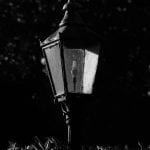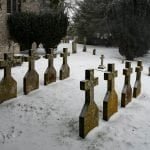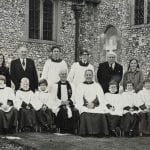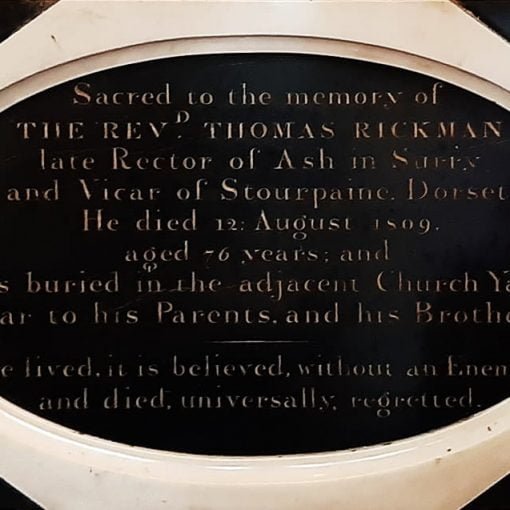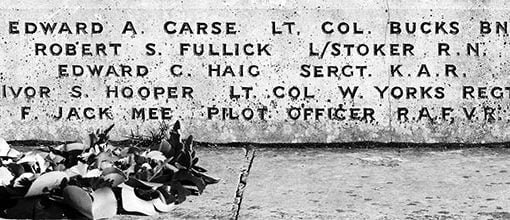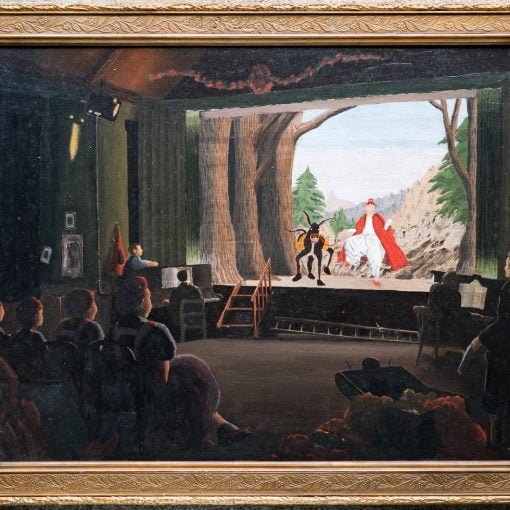A Verger Remembers
by Ralph Burn[1]In the Parish Magazine of February 1981 his first name was given as Relph but he appears as Ralph Gilbert George Burn in the births, marriages and census records
This talk was one of four addresses at the “Songs of Praise” patronal festival on 2nd November 1980, held to celebrate the 75th anniversary of the 1905 extension to All Saints’ Church, Compton. It was read out by Dr. A. Phillips.
I was born shortly after the new church was built. That was in the time when Mr. Cooper was Rector of Compton. Altogether I have known seven Rectors, and they have all been different!
- Old lamp still in use in Compton Street – now using an energy saving electric bulb
- The eight matching gravestones in Compton Churchyard, commemorating rector Charles Wickham, his wife and six of their sixteen children
- Compton Choir October 1971. Back row, third from left, Ralph Burn. Front row middle, the Rector, Rev George Fawkes and organist/choirmaster Denis Lee
It was early in the First World War that my father was appointed Sexton and Verger of Compton Church. My mother “did” the school, and as a boy I sang in the church choir. We lived in one half of ‘Church Cottage’ and the school teacher (Miss Clark) occupied the other half.
Among my father’s various duties at that time, he had to look after the oil lamps in Compton Street, which was sometimes so muddy that he had to wear gumboots.
The year 1931 was a very important one for me. It was on Boxing Day in that year that my wife and I were married in Compton Church by Rector Cunningham, and it was in the same year that I took over my father’s job as Sexton and Verger.
One of my tasks was to dig the graves, and I continued doing that until 1960. I remember one occasion when I had to cut short my annual one week’s holiday and come back from Sussex to dig graves for three funerals in a bunch.
For many years the church had been lit by oil lamps. Two of the brackets can still be seen in the sanctuary of the new church. There were 23 of those lamps for me to clean and fill every Saturday morning. It was in 1935 that electric lights were put in, and I remember the remark of one lady on seeing them for the first time: “It looks just like a cinema”.
Before the electricity came, the organ was blown by a water-pump. There was a well in the stoke-hole to take the surplus water. When it was no longer required, I filled it in with ashes from the boiler.
An important person in the parish at that time was General Eden, who for 25 years or so was Churchwarden and Church Treasurer.
Compton Church had a narrow escape one night in wartime when an incendiary bomb fell just outside the south door. You can still see the marks it made on the paving stones there.
For most of my time as Verger, there was no Sacristan, and I had to prepare what was needed for the Communion Services. The first Sacristan was Miss Flint, then it was Miss Hobart and then Mrs. Phillips.
My Sunday duties included ringing the bells – all three of them – a rope in each hand and one in a stirrup. Eventually, about 1950, I had a young volunteer helper, Rachel Phillips, who took the third rope and relieved my foot.
There was a lot to be done in the churchyard, and in summertime work sometimes went on until 10 p.m.
One of the big events each year was Spring Cleaning, which lasted a whole week, between one Sunday and the next. It was spit and polish throughout the church. Not even the roof timbers were left out; Mr. Newman the builder brought ladders and saw to them.
I retired in 1971, and am no longer able to attend services. But All Saints Compton, which has played such a big part in my life, remains the church to which I belong.
This talk was printed in the Compton & Shawford Parish Magazine, February 1981.
We are indebted to the Hampshire Records Office, who retain copies of most past issues since 1928 in their archive (mainly under reference 1M76/PZ)
References
| ↑1 | In the Parish Magazine of February 1981 his first name was given as Relph but he appears as Ralph Gilbert George Burn in the births, marriages and census records |
|---|

